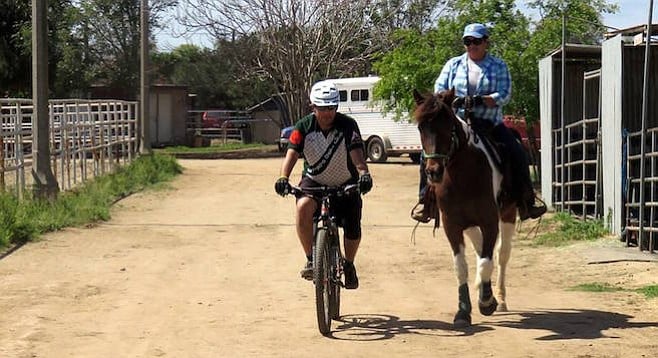 Facebook
Facebook
 X
X
 Instagram
Instagram
 TikTok
TikTok
 Youtube
Youtube

Horses met the bikes — and the riders — at the Wigginton Ranch in the Tijuana River Valley on March 19. Equestrians in jeans and boots ate pizza with mountain bikers in jerseys and helmets before the two groups worked on trail-sharing techniques.
Members of the San Diego Mountain Biking Association came to the ranch, a board-and-train facility off Hollister Road, to help desensitize horses to bikes and to learn how horses see things on the trail.
"She used to get spooky when she'd hear a bike coming," said Yolanda about her horse, “but now she knows what they are and she'll do much better."
Mountain bikers are increasingly sharing trails with horses in the county park (disclosure: I hike there) and there have been problems, including an equestrian who had to be taken to the hospital after her horse spooked and threw her.
A protracted series of negotiations over restricting bikes from horse trails in the county park — an issue on which the equestrian association was divided — led members of both groups to see where they had a lot in common, Vickie Krauss said.
The president of Tijuana River Valley Equestrian Association and a professional trainer, Krauss first trained horses and riders on an emergency stop method, and then went to desensitizing the horses. She gradually began bringing the bike and bicyclists closer together very slowly, watching the horses until they'd relaxed. Eventually, they were effectively simulating being on a trail together.
The mountain-bike association has taken the lead on working with equestrians all over the county, even spending money to buy bells for bikes and place them at the entrances to parks where bicyclists are likely to meet horses on the trail.
On the trail, horses have the absolute right of way, followed by hikers and then bicyclists. But where there's space, trail users will often approach horses, thinking that it's okay to pass them or go around them — and unintentionally frighten the horse.
Horses think like prey, not predators. The big animals have huge blind spots on all sides, and when they see something they don't understand, they react from the mindset of a zebra that sees a lion, Krauss explained.
Equestrians say their biggest concern is with the speeds bikers can reach.
"I was riding and a little boy on a bike comes flying around a corner and he tried to stop when he saw us," said Emma Reese, who brought her horse, Reno, with her. "He laid the bike down and then just laid on the ground right under Reno trying to figure out what to do."
Reese held on to Reno and told the boy to crawl out from under the horse, then dismounted and pulled the boy's bike out and gave it to him."
"We were all lucky — Reno just stood still," Reese said. "Not every horse would have."


Horses met the bikes — and the riders — at the Wigginton Ranch in the Tijuana River Valley on March 19. Equestrians in jeans and boots ate pizza with mountain bikers in jerseys and helmets before the two groups worked on trail-sharing techniques.
Members of the San Diego Mountain Biking Association came to the ranch, a board-and-train facility off Hollister Road, to help desensitize horses to bikes and to learn how horses see things on the trail.
"She used to get spooky when she'd hear a bike coming," said Yolanda about her horse, “but now she knows what they are and she'll do much better."
Mountain bikers are increasingly sharing trails with horses in the county park (disclosure: I hike there) and there have been problems, including an equestrian who had to be taken to the hospital after her horse spooked and threw her.
A protracted series of negotiations over restricting bikes from horse trails in the county park — an issue on which the equestrian association was divided — led members of both groups to see where they had a lot in common, Vickie Krauss said.
The president of Tijuana River Valley Equestrian Association and a professional trainer, Krauss first trained horses and riders on an emergency stop method, and then went to desensitizing the horses. She gradually began bringing the bike and bicyclists closer together very slowly, watching the horses until they'd relaxed. Eventually, they were effectively simulating being on a trail together.
The mountain-bike association has taken the lead on working with equestrians all over the county, even spending money to buy bells for bikes and place them at the entrances to parks where bicyclists are likely to meet horses on the trail.
On the trail, horses have the absolute right of way, followed by hikers and then bicyclists. But where there's space, trail users will often approach horses, thinking that it's okay to pass them or go around them — and unintentionally frighten the horse.
Horses think like prey, not predators. The big animals have huge blind spots on all sides, and when they see something they don't understand, they react from the mindset of a zebra that sees a lion, Krauss explained.
Equestrians say their biggest concern is with the speeds bikers can reach.
"I was riding and a little boy on a bike comes flying around a corner and he tried to stop when he saw us," said Emma Reese, who brought her horse, Reno, with her. "He laid the bike down and then just laid on the ground right under Reno trying to figure out what to do."
Reese held on to Reno and told the boy to crawl out from under the horse, then dismounted and pulled the boy's bike out and gave it to him."
"We were all lucky — Reno just stood still," Reese said. "Not every horse would have."
Comments